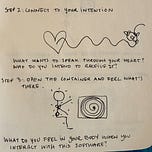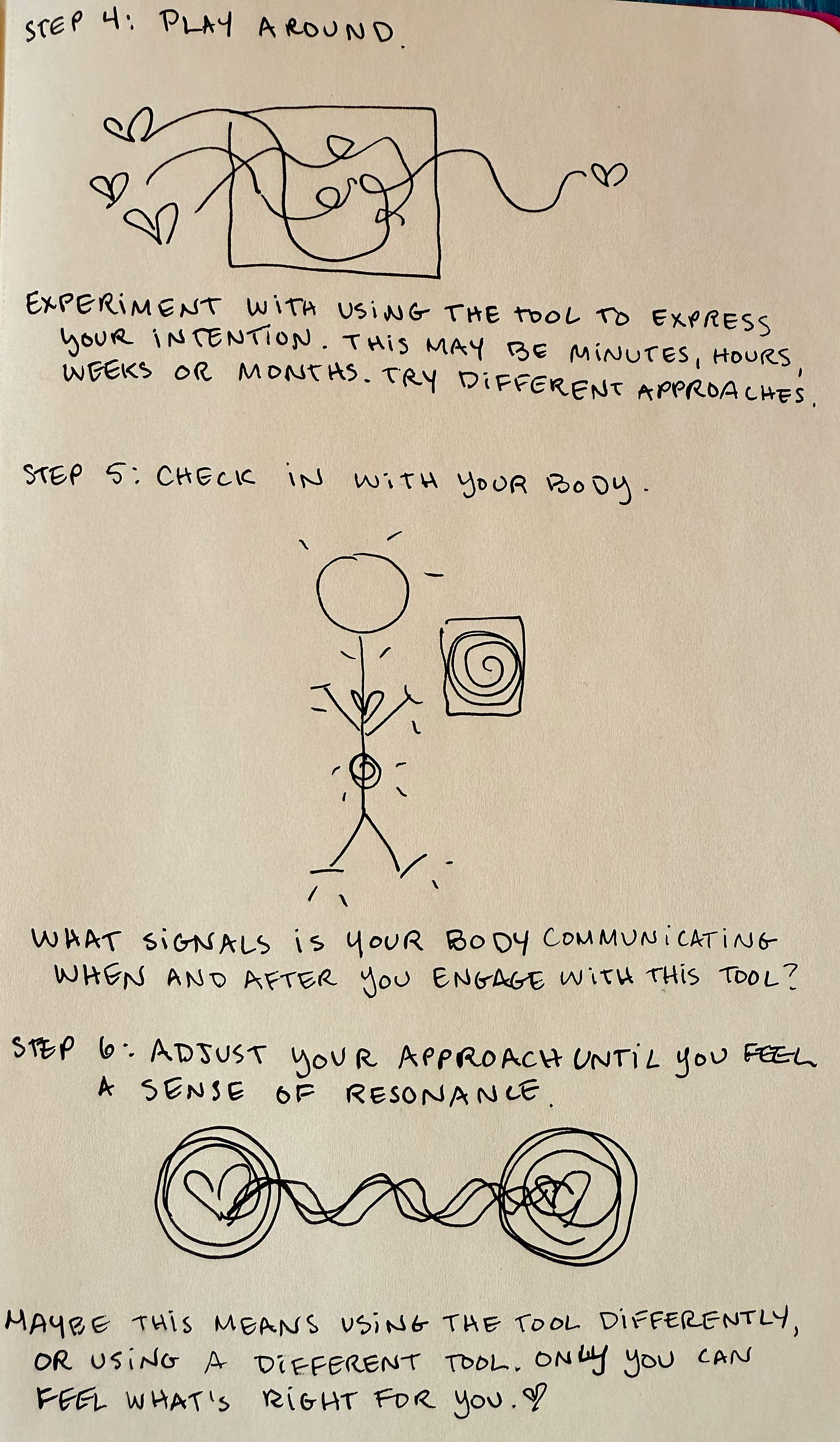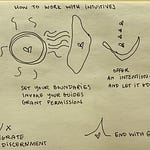I am frequently asked the question, “Do I need to use Instagram/X/Facebook/[insert software or social media platform here]? What about for my business?” My answer is no. There are always multiple paths. If you’re clear about your objectives and your intention, you should never feel like you “have to” embrace one platform or another. The strategy of expressing your intention to people who can receive it is most authentic when it aligns with what feels right for you.
When I say “feels right” I mean not just from an intellectual perspective – do I agree with this company’s values etc. – I mean how does it feel in your body to use this software. I’ll call this an “embodied” perspective. The intellectual perspective places judgment (is this good or bad? Am I good or bad for doing this?); the embodied perspective is your ground truth. Maybe your body feels good when you’re putting your light in a dark place. Maybe that’s not the best use of your time. Only you can feel what’s right for you, and your body will not lie.
This is important because if we can learn to listen to our bodies as we use our tools, those tools can carry the wisdom of our intentions in an aligned, authentic way. We become conductors for what we want to contribute to the world.
A few clarifications before I dive into the substance:
What’s my expertise? I am speaking from my perspective as a former technology analyst for Forrester Research and product marketing executive for Meta, as well as a creative human deeply attuned to energetic alignment. You can consider this guidance as practical and energetic support for intentional technology use.
Who is this for? This guidance applies to individuals and sole proprietors of businesses where you really are your business. I am not speaking here about large businesses where there is more complexity in terms of audience and objectives.
What does this apply to? This guidance focuses on software used for communications, including social media as well as other commonly used platforms (e.g., Zoom, Substack), although you could apply this guidance to other software and even hardware use as well.
So let’s dive in with a few principles.
It’s a legitimate choice to use or not use a platform because you like or don’t like its energy BUT
It’s equally true that you can shape the energy of the platform in some small way by embodying your intention in the way you use the software. AND,
Noticing the resistance you have to using a platform can be a powerful teacher for attuning to yourself, reinforcing your boundaries, and clarifying what feels like “you” and “not you.” This resistance can point the way to a more aligned path forward.
I’ll share some examples of how I apply these principles in my own life, and then some practical steps to explore for your own intentional technology use from an embodied perspective.
Three examples of what intentional technology use has felt like for me
My journey from Facebook to Substack
I was user number 19,403 on Facebook. I joined when it was still a community only open to Harvard students, and I stopped using Facebook several years later when I worked at Forrester Research and my work colleagues joined; at that time, it felt weird to mix my communities and my identities together. My account lay dormant until I applied to work at Facebook (now Meta) and I had to reactivate my account to log in and complete the application. I was worried I’d be “found out” as not a real Facebook user but quickly realized that, with my first role working in privacy, having some objectivity about the platform was a useful attribute.
Still, I wanted to participate and use the tool I was now helping to build. However, I didn’t want to interrupt our family moments to take pictures and post them; that didn’t feel authentic to me and I felt tension in my stomach with that approach. I realized that I had an art practice of cooking and taking photographs, and posting them to Facebook along with stories about what I was feeling as I cooked felt like a continuation, not a disruption, of my process. It felt like an expansion of my heart. That was the start of “recipe as feeling,” and I continued all the years I worked at Facebook. When I quit in March 2021, I paused.
In my pause, I realized I still felt connected to this process and this intention of creating recipes as feelings, but Facebook no longer felt like the right platform through which to share them. I loved how Alison Roman used Substack to share her personal stories as well as her recipes as she went through her transitions in her career and public life. When I created Recipe as Feeling, Substack felt delightful – it seemed like every time I used it I would see a new feature they released, like audio voiceover, that felt even more aligned with what I put into the world. The format of a subscription-based email newsletter fosters a feeling of connection I have with people who choose to subscribe (here too :). My process started with my search to find an aligned way to use Facebook, and led me to deepen my relationships with friends, family, and former colleagues through self-reflection and correspondence.
Releasing perfectionism on Instagram
Even though I worked at Facebook for 7+ years and the tools and teams I worked with included Instagram, I never used Instagram for my own purposes while I worked there. I felt like Instagram, with its origins in photography and filters and precise formats, lent itself to perfectionism, and I was wary of exacerbating my own perfectionist tendencies. I didn’t want to participate in something that I didn’t have the headspace to fully understand and commit to, and at the time, I didn’t feel like I had the time and space to figure it out – to engage with intention. It felt like a headache.
When I left my job, I had the time and space to explore an intentional use of Instagram. It felt aligned to have some expression of Recipe as Feeling there, for several reasons. One, there’s a strong presence of people involved with food on the platform, and many people I met post-Facebook who were farmers, producers, and chefs used Instagram in beautiful and creative ways. Two, this community was not the same as the community who subscribed to my Substack, though there is some overlap, so it offered the opportunity to communicate to a different audience who might not ever subscribe, but might enjoy what I am expressing. Three, it felt like a platform that could carry poetry and story, and it was fun to relay the feeling of my Substack emails in this visual format. It was challenging to learn a new tool, but it felt exciting and energizing in my body whenever I would engage with it.
Over time, I’ve tried different techniques, learning and adjusting based on feedback from friends (e.g., I started with just images of what I was cooking, until my friend Kristen urged me to include my smiling face). Using Instagram (or any communications technology) with intention is not just about what energy I’m putting in, but also about what energy it meets, how it’s received, and what wavelength comes out of that interaction.
Four years with (almost) no Zoom
I am not alone in feeling resistance to videoconferencing. Research has shown that a number of issues combined including lack of social cues, cognitive overload, reduced mobility, intense eye contact, and more have the effect of taxing our nervous system. For me, using videoconference software on my computer or phone (I’ll use Zoom as a shorthand for this but it’s also Google Meet, what used to be Bluejeans, FaceTime, etc.) is an intensely negative visceral experience. It feels like when the television is on but the screen is black (like if we’ve turned off the PlayStation but the tv power is still on), emitting a subtle high-pitched whine of static. I feel it in my entire core and all the joints in my body. It’s like nails on a chalkboard. You get the idea.
A gift of leaving my job is that I get to choose what tools I use. Rather than continue to use Zoom, I’ve listened to my body’s resistance and deepened other practices I have for connection. In my volunteer work, I would take walks for 1:1s and attend meetings in person. For my startup, I’ve partnered with my neighbor Sandra; we walk to each other’s houses for our work sessions and cook each other lunch. For friend interactions, I’ve embraced exchanging audio messages, and enjoy listening and responding at my own pace. I will only use videoconferencing when there is no other physical way to share my screen and talk someone through something visual at the same time. When I do this – for example, giving someone a tour of what I’m building – I will take care to ground and nourish myself before and after, with fresh air, movement, food and water.
Practical steps for listening to your body and channeling your intention
Ground yourself. Do whatever feels right for you to be able to listen to your body. Maybe it’s a walk outside, some stretching and breathing, cooking, eating. Feel where your body touches the ground and notice what you notice.
Connect to your intention. In this grounded state, ask yourself what wants to speak through you. Who is it intended for? What is the intention you want to communicate? Where do you feel that originating in your body? If it’s not clear, put your hand on your chest and ask your heart.
Open the container (software) and feel what’s there. When you pull up the app or website, what sensations do you notice in your body? A sensation can be a temperature change, a tension or release, a sound, or any kind of impression. It could be located in a specific place like your head or your stomach or your hip, or it could be a general feeling throughout your body. Notice what continues or changes as you use the software.
Play around. Experiment with the tool with however much time feels right for you. It could be minutes, hours, weeks, months. Try out different features, formats, settings, techniques. Notice what you notice.
Check in with your body. While you are experimenting and using the software, what signals are you receiving through your body? What do you notice after you complete a session using the software? What has changed?
Adjust your approach until you feel a sense of resonance. Maybe this means using the tool differently, or using an entirely different tool. What you’re looking for is a feeling like a song: Does what you’re singing feel like it’s in resonance with what’s flowing through the software, or does it sound dissonant and off-key? Does it feel like ease or resistance? What’s happening with your intention – is what you’re expressing received or does it hit obstacles? How does your body feel?













